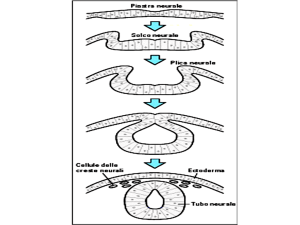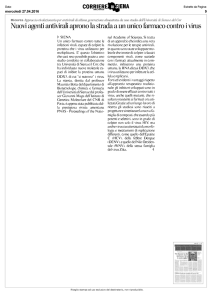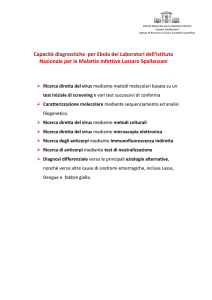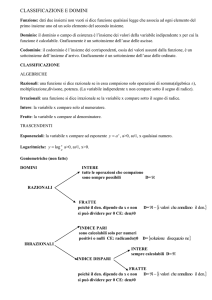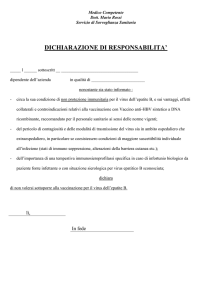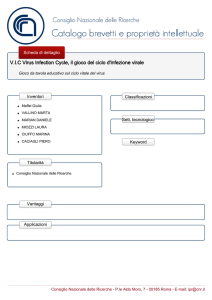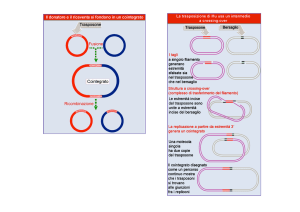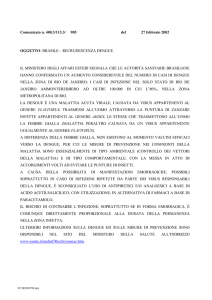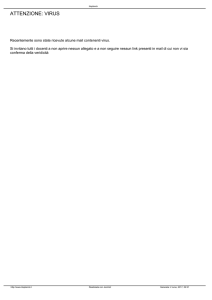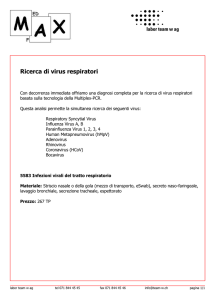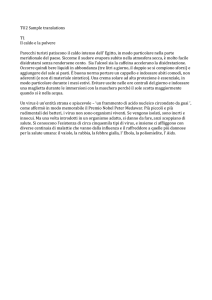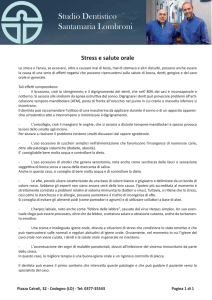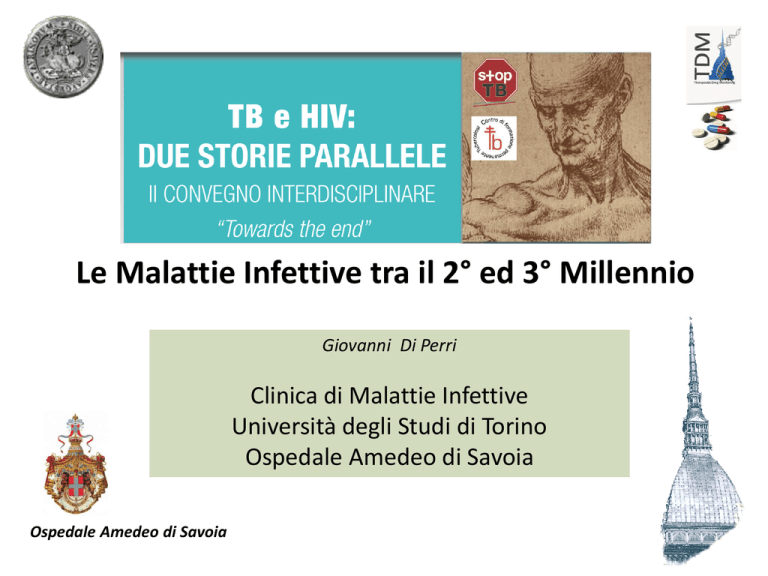
Le Malattie Infettive tra il 2° ed 3° Millennio
Giovanni Di Perri
Clinica di Malattie Infettive
Università degli Studi di Torino
Ospedale Amedeo di Savoia
Ospedale Amedeo di Savoia
The 10 Leading Causes of Death, Global, 2000 and 2012
No
Causes of death, 2000
Deaths
(million
)
% of
deaths
No
Causes of death, 2012
Deaths
(million)
% of
deaths
1 Ischaemic heart disease
6.0
11.3
1
Ischaemic heart disease
7.4
13.2
2 Stroke
5.7
10.7
2
Stroke
6.7
11.9
3 Lower respiratory infections
3.5
6.6
3
COPD
3.1
5.6
4 COPD
3.1
5.8
4
Lower respiratory infections
3.1
5.5
5 Diarrhoeal diseases
2.2
4.1
5
1.6
2.9
6 HIV/AIDS
1.7
3.2
6
Trachea, bronchus, lung
cancers
HIV/AIDS
1.5
2.8
7 Tuberculosis
1.3
2.5
7
Diarrhoeal diseases
1.5
2.7
8 Prematurity
1.3
2.5
8
Diabetes mellitus
1.5
2.7
9 Trachea, bronchus, lung
cancers
10 Diabetes mellitus
1.2
2.2
9
Road injury
1.3
2.3
1.0
2.0
10 Hypertensive heart disease
1.1
2.0
11
Prematurity
1.1
2.0
13
Tuberculosis
0.9
1.7
12 Road injury
16 Hypertensive heart disease
1.0
0.8
1.9
1.6
Comparison of leading causes of deaths, Global, 2000 and 2012
Leading Causes of Global Deaths from Infectious Diseases.
Fauci AS, Morens DM. N Engl J Med 2012;366:454-461
Emerging Infections in the
World since 1973
1973
1976
1977
1977
1977
1977
1980
1981
1982
1982
1982
Rotavirus
Cryptosporidium
Ebola virus
Legionella
Hantaan virus
Campylobacter
HTLV-1
Toxin prod. S.aureus
E.coli 0157:H7
HTLV-II
Borrelia burgdorferi
Enteritis/Diarrhea
Enteritis/Diarrhea
VHF
Legionnaire’s dz
VHF w/ renal flr
Enteritis/Diarrhea
Lymphoma
Toxic Shock Synd.
HUS
Leukemia
Lyme disease
1983
1983
1988
1989
1990
1991
1992
1992
1993
1994
1994
1995
1995
1996
1997
1999
1999
HIV
Helicobacter pylori
Hepatitis E
Hepatitis C
Guanarito virus
Encephalitozoon
Vibrio cholerae O139
Bartonella henselae
Sin Nombre virus
Sabia virus
Hendra virus
Hepatitis G
Herpesvirus-8
vCJD prion
Avian influenza (H5N1)
Nipah virus
West Nile virus
AIDS
Peptic ulcer dz
Hepatitis
Hepatitis
VHF
Disseminated dz
Cholera
Cat scratch dz
Hanta Pulm Synd
VHF
Respiratory dz
Hepatitis
Kaposi sarcoma
Variant CJD
Influenza
Encephalitis
Encephalitis
2000
Outbreak of Rift Valley fever in Saudi Arabia and Yemen, representing the first
reported cases of the disease outside the African continent
2003
Global outbreak of severe acute respiratory syndrome (SARS) caused by a
previously unknown coronavirus associated with Chinese horseshoe bats
2003
Cases of monkeypox in the United States linked to exotic pets imported from
Central Africa
2003
Reemergence of avian influenza A (H5N1) in Southeast Asia and subsequent
outbreaks in Africa
2005
Marburg hemorrhagic fever outbreak in Angola
2005-2006
Large outbreak of chikungunya in the Indian Ocean islands of Réunion and
Mauritius
2006
Rift Valley fever outbreak in Kenya
2007
Ebola hemorrhagic fever outbreak in the Democratic Republic of the Congo
2007
Outbreak of Nipah virus encephalitis in Bangladesh
2007
First detection in Italy of mosquito-borne transmission of chikungunya fever,
previously detected only in parts of Africa and South and Southeast Asia
2007
Hemorrhagic fever outbreak in Uganda caused by a new stain of Ebola:
Bundibugyo Ebola virus
2007
Outbreak of Marburg hemorrhagic fever in Uganda
2008
Ebola-Reston virus detected in pigs in the Philippines
2008
Ebola-like outbreak in Zambia due to a previously unknown virus: Lujo
hemorrhagic fever virus, an arenavirus related to Lassa fever virus, which is associated with
rodents
2009
Outbreak of severe fever with thrombocytopenia syndrome (SFTS) in China
caused by a novel phlebovirus (the SFTS virus)
2009
Discovery of two novel tick-borne pathogens in the United States: the Heartland
phlebovirus in Missouri and a pathogenic Ehrlichia species in Wisconsin and Minnesota
2009-2010
Influenza pandemic caused by a new influenza strain, influenza A(H1N1)
2009-2010
Locally transmitted dengue in Florida, representing the first cases acquired in
the continental United States outside the Texas-Mexico border since 1945
2012
Ebola hemorrhagic fever outbreaks in Uganda and the Democratic Republic of the
Congo
2012
Outbreak of Marburg hemorrhagic fever in Uganda
2011-2012
Influenza cases in the United States traced to a variant swine influenza
A(H3N2) virus carried by pigs exhibited at agricultural fairs
2012
Outbreak of hantavirus pulmonary syndrome in Yosemite National Park,
California
2012
A novel rhabdovirus (Bas-Congo virus) identified by whole-genome sequencing as
the cause of an outbreak of acute hemorrhagic fever in the Democratic Republic of the
Congo
2012-2013
Outbreak of severe respiratory disease in the Middle East caused by a novel
coronavirus (MERS-CoV) that belongs to the same viral family as the SARS coronavirus
2012-2013
Influenza cases in China traced to avian influenza A(H7N9) virus in poultry
2013-2016 Ebola epidemic in Sierra Leone, Liberia and Guinea Conackry
•
•
•
•
•
•
New agents,
New clinical forms of infections caused by known pathogens
Cross-species passage of pathogens
Transmission through continents
New forms of human immune suppression, vulnerability
………….
Old and New Infectious Diseases….
How to classify them ?
Ve lo ricordate quel testo di Borges (citato anche da Michel Foucault nella
prefazione al suo celebre saggio Les mots et les choses) dove si proponeva una
grottesca classificazione degli animali desunta da una non meglio precisata
enciclopedia cinese?
Era una tassonomia fondata sul puro delirio:
“Gli animali si dividono in:
a)
b)
c)
d)
e)
f)
g)
h)
i)
j)
k)
l)
m)
n)
appartenenti all’Imperatore,
imbalsamati,
addomesticati,
maialini di latte,
sirene,
favolosi,
cani in libertà,
inclusi nella presente classificazione,
che si agitano follemente,
innumerevoli,
disegnati con un pennello finissimo di peli di cammello,
et caetera,
che fanno l’amore,
che da lontano sembrano mosche”.
Per agente causale…. Secondo la via di trasmissione….
Secondo l’età
a. Batteriche
a. Via aerea
dell’ospite….
b. Virali
b. Via alimentare
c. Fungine
d. Parassitarie
e. Prioniche
c. Da inoculazione
-
Trasfusioni
Siringhe
Rapporti sessuali
Esposizione di cute e/o mucose
Secondo il distretto o organo
coinvolto….
a.
b.
c.
d.
e.
f.
g.
h.
i.
Sistemiche
Polmonari
Renali
Epatiche
Intestinali
Ossee
Cutanee
Muscolari
Sistema nervoso
Secondo lo stato dell’ospite….
a. Popolazione generale
b. Immunodepressi
-
Diabetici
Emato/oncologici
Ustionati
In terapia antineoplastica
In terapia immunosoppressiva
Infezione da HIV
etc….
a.
b.
c.
d.
Popolazione generale
Neonatologia
Pediatria
Geriatria
Secondo variabili
epidemiologiche….
a. Comunitarie
b. Associate all’assistenza
(Healthcare-related)
c. Nosocomiali
d. Tropicali
Review Article: 200th Anniversary Article
The Perpetual Challenge of Infectious Diseases
Anthony S. Fauci, M.D., and David M. Morens, M.D.
N Engl J Med
Volume 366(5):454-461
February 2, 2012
Characteristics of Infectious Diseases That Set Them Apart from Other Human Diseases.
*
*
*
*
*
*
*
*
*
*
Fauci AS, Morens DM. N Engl J Med 2012;366:454-461
Broad Categories of Infectious Diseases.
Fauci AS, Morens DM. N Engl J Med 2012;366:454-461
Emerging infectious diseases:
• infectious diseases that have newly
appeared in a population.
Re-emerging infectious Diseases:
• Infectious diseases incidence in
human has increased during the
last 20 years or threatens to increase
in the near future.
Major Factors Contributing to
Emerging Infections: 1992-2003
1.
2.
3.
4.
5.
6.
Human demographics and behavior
Technology and Industry
Economic development and land use
International travel and commerce
Microbial adaptation and change
Breakdown of public health measures
Institute of Medicine Report, 1992
More Factors Contributing to
Emerging Infections: 1992-2003
7. Human vulnerability
8. Climate and weather
9. Changing ecosystems
10. Poverty and social inequality
11. War and famine
12. Lack of political will
13. Intent to harm
Institute of Medicine Report, 2003
The Global Threat of Infectious Diseases
Emerging and re-emerging diseases
A/H1N1
Dengue
A/H1N1
Chikungunya
Dengue
Adapted from Morens, Folkers, Fauci 2004 Nature 430; 242-9
Emerging diseases
Re-emerging diseases
Major Infectious Disease Epidemics since 1980
•
•
•
•
•
•
•
•
•
•
•
•
•
•
Dengue/DHF-1970s, SE Asia, global
HIV/AIDS-1980s-Africa,global
Drug resistant TB-1990s, US, global
Cholera-1991-Americas
Plague-1994-India, global
Foot & Mouth disease-1995,2000- Taiwan & UK
West Nile-1990s-Mediterranean, Americas
BSE-1990s- UK, Canada, US
Swine fever, 1996- Netherlands
H5N1 influenza-1997- HK-global
Nipah encephalitis-1998-Malaysia,Asia
SARS-2002- Asia, global
Chikungunya-2004-Africa, Asia
H1N1 influenza-2009-Mexico?,global
What did these Epidemic Infectious Diseases
have in Common?
• All were caused by zoonotic pathogens
• All spread by modern transportation
• Most had Asian origin
• Laboratory and clinical diagnoses were problematic
• Poor communication among countries
• Major economic impact
Plague Pandemics
• Justinian’s Plague (mid-6th Century A.D.)
• Black Death (mid-14th Century A.D.)
• Modern Pandemic (1894 – mid-1900s)
Global Distribution of Plague
Countries reporting plague, 1970-2000
Probable Sylvatic foci
Compiled from WHO, CDC, and country sources
Surat
Potential Spread of
Pnuemonic Plague
out of India, 1994
India
Delhi
Calcutta
Madras
Bombay
Pneumonic Plague in India
• Indian outbreak was a
major surprise – no plague
confirmed in India since
1966
• Clinical and lab diagnosis
• Media and panic driven
epidemic
• First epidemic to impact
global air transportation
• Caused huge economic
loss for India (> $3 billion)
Palm civet (zibetto) animal reservoir of SARS coronavirus
•
•
•
•
•
•
All were caused by zoonotic pathogens
All spread by modern transportation
Most had Asian origin
Laboratory and clinical diagnoses were problematic
Poor communication among countries
Major economic impact
Chain of transmission among guests at Hotel M—Hong Kong, 2003
2 family
members
2 close contacts
4 family
members
Guangdong
Province,
China
4 HCWs*
Hospital 2
Hong Kong
F
A
A
F
156 close
contacts
of HCWs
and
patients
Hospital 3
Hong Kong
H
Hospital 1
HK
J
B
C
28 HCWs
4 other
Hong Kong
Hospitals
Vietnam
B
D
HCW
HCW
United
States
M§
D
E
Singapor
e
HCW
34 HCWs
Bangkok
Data as of 3/28/03
I
Germany
0 HCWs
Hospital 4
Hong Kong
Ireland
L§
E
C
B
K†
I
Hotel M
Hong
Kong
J
99 HCWs
(includes 17
medical students)
K†
A
H
Canada
G†
G†
3 HCWs
10 HCWs
37 HCWs
37 close contacts
HCW
2 family
members
Unknown
number close
contacts
* Health-care workers; † All guests except G and K stayed on the 9 th floor of the hotel. Guest G
stayed on the 14th floor, and Guest K stayed on the 11th floor; § Guests L and M (spouses) were not
at Hotel M during the same time as index Guest A but were at the hotel during the same times as
Guests G, H, and I, who were ill during this period.
Global SARS Cases (Probable)
WHO 26 September 2003
Global SARS Cases (Probable)
WHO 26 September 2003
Country
Cases
Deaths
Case fatality
Canada
251
43
15.3%
China
5327
349
6.5%
Hong Kong
1755
299
16.9%
Singapore
238
33
15.5%
Taiwan
346
37
12.5%
Thailand
9
2
22%
U.S.
75
0
0%
Vietnam
63
5
7.9%
Other
81
5
6.2%
Total
8098
774
9.6%
Economic Impact of Selected Infectious Diseases
Plague, India
$5-6 bn
Why Have we Seen Such a Dramatic
Increase in Epidemic Infectious Diseases?
Major Drivers
•
Demographic Changes (Pop Growth)
Environmental Change
-
•
•
Uncontrolled Urbanization
Agricultural/Land Use Practices
Deforestation
Animal Husbandry
Modern Transportation (Globalization)
Increased Movement of People, Animals, Commodities
Lack of Public Health Infrastructure
The global air network
Average annual number of global airline
passengers by decade, 1950-2010
2000
Million of Passenger (Mil)
1800
1600
1400
1200
1000
800
600
400
200
0
1950-1960
IATA 2010
1970-1980
1980-1990
Decade
1990-2000
2000-2009
International tourist arrivals, actual trends and forecast, 1950-2030
Commercial Air Traffic Over a 24 Hour Period
Global distribution of dengue virus serotypes, 1970
DEN 1
DEN 2
DEN 3
DEN 4
DEN 1
DEN 2
Gubler, 1998
DEN 1
DEN 2
Global distribution of dengue virus serotypes,
1970-2000
1981
1977
1980
1979
1981
1994
1982
1985
1975
1971
DENV – 1; DENV – 2; DENV – 3; DENV – 4
Global distribution of dengue virus serotypes,
1970-2000
Global distribution of dengue virus serotypes,
1970-2000
1971
DENV – 1; DENV – 2; DENV – 3; DENV – 4
Global distribution of dengue virus serotypes,
1970-2000
1975
1971
DENV – 1; DENV – 2; DENV – 3; DENV – 4
Global distribution of dengue virus serotypes,
1970-2000
1977
1975
1971
DENV – 1; DENV – 2; DENV – 3; DENV – 4
Global distribution of dengue virus serotypes,
1970-2000
1977
1979
1975
1971
DENV – 1; DENV – 2; DENV – 3; DENV – 4
Global distribution of dengue virus serotypes,
1970-2000
1977
1980
1979
1975
1971
DENV – 1; DENV – 2; DENV – 3; DENV – 4
Global distribution of dengue virus serotypes,
1970-2000
1981
1977
1980
1979
1981
1975
1971
DENV – 1; DENV – 2; DENV – 3; DENV – 4
Global distribution of dengue virus serotypes,
1970-2000
1981
1977
1980
1982
1979
1981
1975
1971
DENV – 1; DENV – 2; DENV – 3; DENV – 4
Global distribution of dengue virus serotypes,
1970-2000
1981
1977
1980
1982
1985
1979
1981
1975
1971
DENV – 1; DENV – 2; DENV – 3; DENV – 4
Global distribution of dengue virus serotypes,
1970-2000
1981
1977
1980
1982
1985
1979
1981
1994
1975
1971
DENV – 1; DENV – 2; DENV – 3; DENV – 4
Global distribution of dengue virus serotypes, 2012
DEN 1
DEN 2
DEN 3
DEN 4
DEN 1
DEN 2
DEN 3
DEN 4
DEN 1
DEN 2
DEN 3
DEN 1
DEN 2
DEN 3
DEN 4
DEN 1
DEN 2
DEN 3
DEN 4
DEN 1
DEN 2
DEN 3
DEN 4
Adapted from Gubler, 1998
DEN 1
DEN 2
DEN 3
DEN 4
DEN 1
DEN 2
DEN 3
DEN 4
DEN 1
DEN 2
DEN 3
DEN 4
Urban Growth in Asian(1) and American(2) Cities, 1950-2010
13
12.4
12
11
10
Millons of People
9
7.8
8
7
6
5.2
4.7
5
4
3
2
1.2
1.3
1
0
1950
1.
2.
1980
2010
Mean population of Dhaka, Bangkok, Jakarta, Manila and Saigon.
Mean population of Rio de Janeiro, Sao Paulo, San Juan, Caracas
and Guayaquil.
Reservoir
Reservoir
Reservoir
Victim
Reservoir
Fighting for food (esp. dry season)
Victim
Reservoir
Infected Victim
Fighting for food (esp. dry season)
Victim
Reservoir
Infected Victim
Fighting for food (esp. dry season)
Monkey /
Man contact
Victim
Reservoir
Infected Victim
Fighting for food (esp. dry season)
Slaughtered
Monkey /
Man contact
Handled
Eaten
Victim
Reservoir
Victim
Infected Victim
Fighting for food (esp. dry season)
Slaughtered
Monkey /
Man contact
Handled
Eaten
Infected
human
Reservoir
Victim
Infected Victim
Fighting for food (esp. dry season)
Slaughtered
Monkey /
Man contact
Infected
human
Handled
Eaten
Interhuman spread
Reservoir
Victim
h
u
m
a
n
s
Infected Victim
b
a
t
s
In caves
Fighting for food (esp. dry season)
Slaughtered
Monkey /
Man contact
Infected
human
Handled
Eaten
Interhuman spread
Reservoir
Victim
h
u
m
a
n
s
Infected Victim
b
a
t
s
In caves
Fighting for food (esp. dry season)
Slaughtered
Monkey /
Man contact
Infected
human
Handled
Eaten
Interhuman spread
Reservoir
Victim
h
u
m
a
n
s
Infected Victim
b
a
t
s
In caves
Fighting for food (esp. dry season)
Slaughtered
Monkey /
Man contact
Infected
human
Handled
Eaten
Interhuman spread
Exotic Mosquito Species Recently
Introduced and Established in the US
•
•
•
•
•
Aedes (Stegomyia) albopictus
Ochlerotatus (Aedes Finlaya) togoi
Ochlerotatus (Aedes Finlaya)
japonicus
Aedes bahamensis
Culex biscayensis
Live Animal Importation into the USA - 2002
• 47,000 mammals
• 28 species of rodents
• 379,000 birds
• 2 million reptiles
• & Poisonous snakes
• 49 million amphibians
• 223 million fish
Data from U.S. Fish & Wildlife Service
Emerging Diseases Identified by NWHC
Inclusion Body
Disease
Nestling
Herpesvirus
1970s
Lake Andes
Duck Plague
Poxvirus
Mycotoxin
Trichothecine
Hepatopathy
(Mycotoxin?)
1980s
Eastern Equine
Encephalitis
Pentobarbitol
Poisoning
Woodcock
Reovirus
Emerging Diseases Identified by NWHC
1990s
Sea Otter
Encephalitis
Hawaii Disease
Biocomplexity
Avian
Myelinopathy
Newcastle
Disease
2000s
Rainbow
Trout
Enteritis
Stunting,
Humpback
Chub
Hepatopathy
in Wisconsin
Splenitis,
Hepatitis
in Brant
Chytrid
Fungus/
Ranavirus
L. polyoon
Enteritis
Sea Turtle
Retrovirus
Poisoning
in Asian
Vultures
???
Coral
Coccidiosis,
Tumors
LT Duck
Adenovirus
Tuesday, Oct 16, 2012
http://www.dailymail.co.uk/science
The Armageddon virus: Why experts fear a
disease that leaps from animals to humans
could devastate mankind in the next five
years
•Warning comes after man died from a Sars-like virus that had
previously only been seen in bats
•Earlier this month a man from Glasgow died from a tick-borne
disease that is widespread in domestic and wild animals in Africa
and Asia
Pathogens of Tomorrow
From Whence They Will Come?
From Asia
From Animals
Mostly Viruses
68
Global Threat of Epidemic Infectious Diseases
Challenge to Reverse the Trend
•
•
•
•
Prevent movement of pathogens and vectors via modern
transportation
Improve international cooperation and data sharing
Improve effective laboratory-based surveillance
Rebuild public health infrastructure to prevent & control vector-borne
and zoonotic diseases
Trained personnel
Laboratory and epidemiologic capacity
Tools (vaccines, drugs, insecticides, mosquito control, etc)
•
Understanding disease ecology
Political will
Economic support
Regional prevention and control programs
Sospetto Diagnostico
Cultura Clinico-Epidemiologica
Prevenzione
Diagnostica
Performance indipendente dal
mercato
Terapia
Performance indipendente dal
mercato
Strategie, Tattiche atte a
preservare il valore di vecchi e
nuovi farmaci nel tempo (e.g.,
polichemioterapia, alte dosi)
Sospetto Diagnostico
Cultura Clinico-Epidemiologica
Prevenzione
Diagnostica
Performance indipendente dal
mercato
Terapia
Performance indipendente dal
mercato
Strategie, Tattiche atte a
preservare il valore di vecchi e
nuovi farmaci nel tempo (e.g.,
polichemioterapia, alte dosi)
Stewardship Applicazioni
Etiologia
•
•
•
•
•
MRSA
VRE
ESBL
KPC
R-FQ
Diagnosi
•
•
•
•
•
•
CAP
HCAP
HAP / VAP
EI / BSI
Tbc
….
Reparto
• Chirurgia
– Profilassi
– Terapia
• Medicina Interna & DEA
• Terapia Intensiva
• Oncoematologia
Molecole / Consumo
• Vancomicina, Carbapenemi, Fluorochinoloni
• Daptomicina, Linezolid, Pip/tazo,
• Antifungini……
Stewardship Network
Tribal
Governments
Department of
Interior
NonGovernmental
Organizations
General
Public
State
Wildlife
Agencies
Other
Federal
Agencies
"Rapid and appropriate treatment is vital in cases of malaria," says
Professor Balbir Singh, Director of the Malaria Research Centre at
the Faculty of Medicine and Health Sciences, University Malaysia
Sarawak, "but before the development of molecular detection
methods, we had been hampered by our inability to distinguish
between P. knowlesi and the benign P. malariae parasites by
microscopy. This parasite multiplies rapidly and can cause fatal
human infections, so it is vital that doctors are aware that P.
knowlesi is the fifth cause of human malaria.
“…it is time to ‘close
the book on
infectious diseases’.”
(U.S. Surgeon
General, 1967)
“During the last 150 years
the Western world has
virtually eliminated death
due to infectious disease.”
(U.S. Surgeon
General, 1975)
“….. Per questo forse m’era stato concesso l’esonero;
per questo io solo m’ero salvato e nessun altro, dalla
falcidia: per rendere testimonianza, se non delazione,
d’una retorica e d’una pietà.
Benchè sapessi già allora che avrei preferito starmene
zitto e portarmi lungo gli anni la mia diceria al sicuro
sotto la lingua, come un obolo di riserva, con cui pagare
il barcaiolo il giorno in cui mi fossi sentito, in seguito ad
altra e meno remissibile scelta o chiamata, sulle soglie
della notte”.
Gesualdo Bufalino
da “Diceria dell’Untore”
Sellerio Editore, Palermo,
Pag. 136
TORINO:
Stefano Bonora
Antonio D’Avolio
Mauro Sciandra
Alessandra Ariaudo
Micol Ferrara
Alice Trentalange
Marco Siccardi
Nicole Pagani
Lorena Baietto
Lucio Boglione
Cristina Tettoni
Sarah Allegra
Sabrina Audagnotto
Debora Pensi
Letizia Marinaro
Jessica Cusato
Margherita Bracchi
Laura Trentini
Andrea Calcagno
Marco Simiele
Amedeo De Nicolò
Pino Cariti
Paolo Bigliano
Ilaria Motta
Silvia Corcione
Maria Laura Stella
Filippo Lipani
Maurizio Milesi
Roberto Bertucci
Ambra Barco
Agostino Maiello
Mattia Trunfio
Marino Bonasso
Simone Mornese Pinna
Chiara Alcantarini
Chiara Cardellino
LIVERPOOL:
David Back
Saye Khoo
Andy Owen
Marco Siccardi
Fabio Favata
Giovanna Fatiguso
Chiara Montrucchio
THE UNIVERSITY
of LIVERPOOL
Valeria Ghisetti
Anna Lucchini
Francesco G. De Rosa
Acknowledgments
Veronica Pirriatore
Silvia Scabini
LONDON:
ROMA:
Marta Boffito
Andrea Antinori
Margherita Bracchi
Emanuele Nicastri
Nicole Pagani
Giuseppe Ippolito

